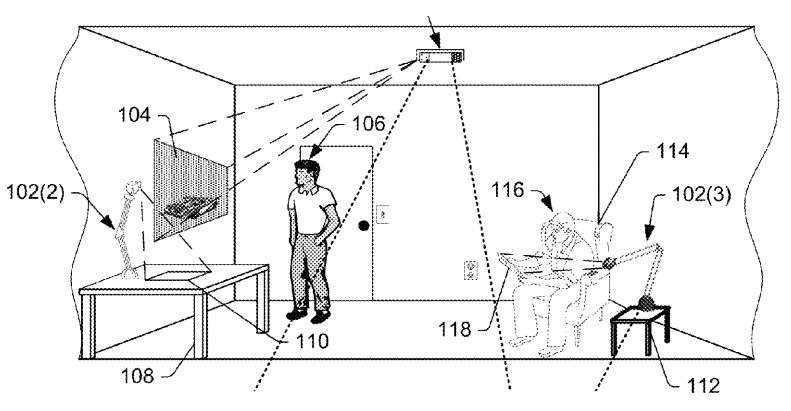Credit: US Patent
Amazon is making some noise in technology for augmented reality environments. Amazon Technologies in Seattle has two patents which present systems and methods for projecting a digital world into the room.
Spencer Soper and Jack Clark in Bloomberg translated the patent talk: Amazon is working on augmented reality for the living room.
This is the kind of augmented reality technology "normally associated with futuristic military training and video-game conventions," they said, and Amazon "is trying to lower the cost of augmented reality," which could drive the technology into living rooms.
A US patent filing called "Object tracking in a 3-dimensional environment" presents discussion of a person, minus keyboard, who could navigate by body movements or via headset or camera for interactions.
The inventors are named as Samuel Chang of San Jose and Ning Yao of Cupertino, California. The patent was filed in 2013.
As background information, the patent read, "User interfaces have traditionally relied on input devices such as keyboards, which require physical manipulation by a user. Increasingly, however, it is desired to detect and monitor the physical positions and movements of users within a scene or environment. User motions and gestures can be used in some environments as user commands and inputs to automated systems. In particular, hand gestures may be useful in providing input from a user to a computerized system."
Making use of a person's motions and gestures as inputs to automated systems, however, has not been trivial—tracking the movement of a user's hand over time has been a challenge. According to the patent, "there is a need to improve ways to track the hand of a user within a scene or environment."
The system described in the patent has one or more processors; one or more cameras for at least a first 3D image of an environment at a first time and a second 3D image of the environment at a second time; and one or more computer-readable media storing computer-executable instructions.
The Bloomberg writers explained that people would get to control their devices with their hand gestures, monitored by cameras recognizing different parts of the hand.
"Reflector-based depth mapping of a scene" is the title of the other patent, filed earlier in 2012. The inventors named are Eric Marason, Christopher Coley and William Weatherford.
The patent talks about a system comprising: "a light source configured to output light beams within a physical space; a shutter mechanism associated with the light source and configured to selectively cause: a first set of the light beams from the light source to be directed towards the physical space and away from an ellipsoidal reflector, the first set of light beams illuminating the physical space at a first time; and a second set of the light beams from the light source to be directed towards the ellipsoidal reflector and away from the physical space, the ellipsoidal reflector reflecting the second set of light beams towards the physical space such that the second set of light beams as reflected by the ellipsoidal reflector illuminates the physical space at a second time; a camera configured to capture a first image of the physical space at the first time and a second image of the physical space at the second time; and a depth determination module configured to generate a depth map of the physical space based at least in part on the first image and the second image, the depth map being used to determine a depth of an object within the physical space."
Translation: Soper and Clark said the depth-mapping patent "would use computer projections to transform a room into a virtual setting that responds to the user's senses."
A single light source, not multiple ones, could pull this off.
The patent said that "the systems and processes described herein may utilize a single light source to determine depth information associated with the scene, without having to recalibrate the system after parameters associated with the reflector and the shutter mechanism are initially determined. Since recalibration of the system may be resource-intensive (e.g., time, cost, etc.), utilizing a single light source with an associated shutter mechanism in order to obtain depth information for a scene, as described herein, is likely to increase the efficiency of the system."
It has become a frequent reminder but always worth noting in stories about patent filings—they are just that and not product or formal project announcements. At the same time, Tyler Lee in Ubergizmo thought about potential uses. Lee wrote, "given that this is a patent, there's no telling if Amazon will ever make it a reality. However it does offer up a lot of potential, like being able to browse products and interact with them before buying them, or being able to watch shows and interact with them without the need for a remote."
© 2015 Tech Xplore
























